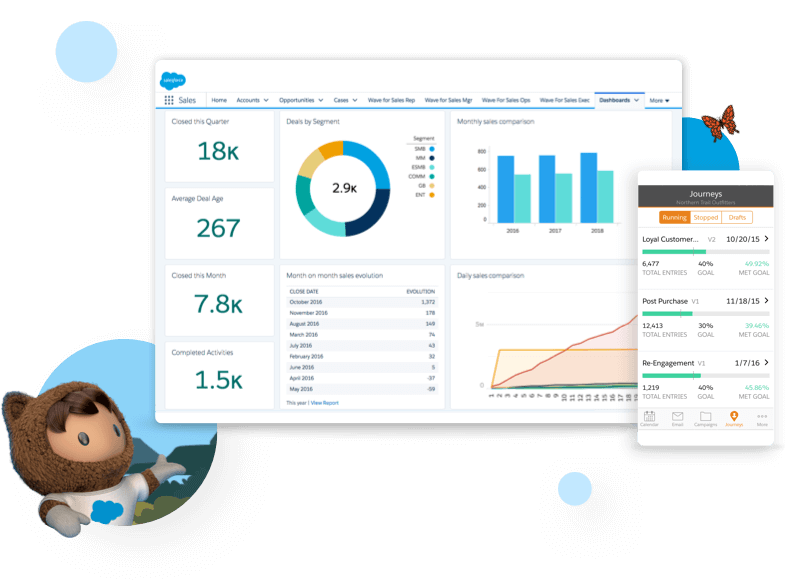Blaze new trail with Field Service, now
In many ways the world in which we operate has changed so radically that the work-flows of just two years ago may today seem antiquated and outdated for many of us in the field service sector.
Yet at the same time when it comes to the fundamentals of service excellence, the essence remains firm – consistently anticipating, meeting and exceeding our customer’s needs. It is a balance that all field service companies are attempting to strike at the moment as Michael Maoz, Senior Vice President, Innovation Strategy, Salesforce, outlines in this in-depth article…
The last year has forced all of us to rethink how we live our lives and run our businesses. In field service, employees and customers are focused on:
- Health and wellness
- Contactless interaction
- Safety
- Self-service and remote support to reduce onsite visits
- Job effectiveness to ensure completion the first time
The organizations that excel at field service delivery share two characteristics:
- C-Level executive commitment to field service as an area important to the business
- Collaboration of field operations in an atmosphere of trust and transparency
This demonstrates empathy and an emphasis on alignment with the customer. These organizations recognize the central role that field service has in shaping perceptions about the brand overall. They listen to their customers, field technicians, dispatchers, customer service teams, and ecosystem partners. Amidst ongoing change, they use what they learn to stay aligned with different, and evolving, needs.
The enterprise goal is to profitably deliver a coordinated customer experience that spans the entire customer journey. In this way, the brand promise is consistent and reinforced at each step that builds lasting bonds with the customer.
The realities of customer expectations in modern field service:
Customers expect field service to be as rewarding and easy as the best service experiences they have anywhere. The businesses that demonstrated innovation courage during the global pandemic were rewarded with strong growth. This innovation courage came through particularly strongly in field service, where every technician visit held the potential of a risk to health. The best companies reacted immediately and reexamined their technology priorities. They relegated long running strategic projects in favor of short sprints like remote visual support.
With remote support, customers can use their video camera to show a field engineer the issue. The customer doesn’t need anyone to come onsite, and gets faster resolution; the company saves the truck roll. Making this more powerful, an AI component can be used to suggest possible root causes. A second AI component inside of the content management solution can extract the repair documents and instructions most relevant to the particular issue.
When needing to go onsite, to provide the best experience, companies have shortened booking windows and provide proactive notifications on arrival time to keep customers updated and give them time to get ready. This reduces missed appointments, increases effectiveness, and provides a better experience for both the customer and the employee.
“One of our customers completely re-platformed their aging and disconnected software for phone support, website, mobile app and technician mobile applications onto a single platform from Salesforce. The resulting speed, consistency, and contactless service allowed them to accelerate business during the pandemic.”
There are great cost savings through the combination of technologies such as remote visual support to significantly reduce the number of field visits, together with content discovery and appointment management, which speeds up the time to repair and shortens the onsite visit.
Beyond the cost savings to the enterprise, the use of new technologies and processes in a reimagined world of field service demonstrates empathy and alignment with the customer and with the employee, particularly during the pandemic, but equally so beyond the pandemic.
Customers expect to engage with their service provider via digital channels with the same easy and intuitive experience that they already have in every aspect of their life. A savvy field service organization needs to connect with their customers on the customer’s preferred channel, which is increasingly SMS and social channels. Customers expect their service providers to know them, know why they’re there, and have the tools necessary to complete the task on the first visit.
Customer-Centricity is Critical:
The best organizations think of what matters most to the customer. The best service visit is the one that never happens to begin with; proactive support and remote resolution are of top importance. When a visit needs to occur, seamlessly managing the appointment is top of mind. The ability to provide the entire care environment is often overlooked.
It is not enough to book the visit at the customer’s desired time. True field service excellence also requires the organization to select the right technician, with the right skills. Excellence requires the organization to communicate the time of arrival, a summary of the work done at the time of the visit, and a follow-up message, through messaging or email, that invites the customer to agree that the work is complete. This final piece: Agreeing that the job is not done until the customer says that it is done, is vital.
There is tremendous upside potential to boost revenue through field service for some industries such as home and business services, HVAC, medical equipment, complex device or infrastructure maintenance.
Many of our customers in these industries are already advanced in providing revenue-generating value-added field services. Some of these are remote diagnostics, remote software updates, remote monitoring, training the customer on best practices, owning centres of excellence that guarantee uptime, and selling uptime rather than selling the product in the first place! Look to these advanced industries. Learn from the best! There is no reason to invent best practices when they already exist in adjacent industries. In all of the cases we have covered, technology has been baked into reimagined processes.
“What are the performance indicators that are the most meaningful to improve the brand? To lower costs? To boost sales? To improve the effectiveness and well-being of employees? To improve the customer experience?”
One of our customers completely re-platformed their ageing and disconnected software for phone support, website, mobile app and technician mobile applications onto a single platform from Salesforce. The resulting speed, consistency, and contactless service allowed them to accelerate business during the pandemic. Their knowledge-empowered technicians to easily build trust with the customer.
These technicians are more highly motivated because they feel the empathy that the business has for them. They also have all of the information in their hands, and they know that the customer is situationally aware. These technicians are in the best position to build brand loyalty and deliver on upsell/cross-sell targets that many service businesses have.
The companies that are the trailblazers in improving field service to be more customer and employee-centric are measuring the value of improvements in five areas:
- Brand loyalty
- Costs
- Sales
- Employee experience
- Customer experience
Selecting the first targets for improvement requires measurement. Here are practical and measurable questions to ask: What are the performance indicators that are the most meaningful to improve the brand? To lower costs? To boost sales? To improve the effectiveness and well-being of employees? To improve the customer experience?
Each of these questions has to be converted into real numbers. To lower costs, you might decide that job duration overruns need to be reduced 25%. For customer experience, you may decide that the customer needs to select their own time window and within a two-hour window, and they must receive a text message upon confirmation and before arrival. These all can be converted into quantifiable numbers.
The savvy field service leader will seize the momentum and move forward boldly with a customer and employee centric approach to innovating field service processes. Define success criteria by selecting the targets you want to measure, determine several relatively small changes to impact those targets, iterate quickly, and measure each process through the eyes of the customer and the technician. There has never been a better time to make the move from follower to leader, and your customers are expecting nothing less.
This content is sponsored by Salesforce

BRING COMPANIES AND CUSTOMERS TOGETHER



